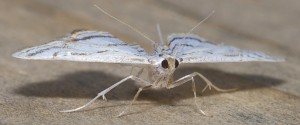
Ever since reading James S. Walker’s article on the egg-laying behavior of Autumn Meadowhawks (Argia Vol. 24, No. 3), I’ve been keen to take a closer look at this behavior myself. I had observed Autumns ovipositing in the past, but always from a distance. This last weekend, the first weekend in October, I finally got my chance. After several days of wind, rain, and temperatures in the low 40s, the sun returned. The transition was dramatic, from completely overcast to clear blue skies in less than an hour. By the time I reached the shore of Bass Lake, a small kettle lake nestled into the wooded hills of Maplewood State Park in western Minnesota, the red dragonflies where out in force. These were mostly Autumn Meadowhawks (Sympetrum vicinum) and Saffron-winged Meadowhawks (Sympetrum costiferum), though I did see one White-faced Meadowhawk (Sympetrum obtrusum) as well. As I made my way away from the trail along the shore of the lake, a darner flew past carrying something large. When it grabbed a perch in a nearby tree, I moved in for a closer look: a female Variable Darner (Aeshna interrupta) eating a female Autumn Meadowhawk. Well, as John Caddy recently reminded me, everybody loves meadowhawks!
Further down the shore the red dragonflies reached rather epic numbers. If I stopped and stood still, Autumn Meadowhawks landed on the brown, sun-warmed leather of my jacket. Every exposed rock or fallen log hosted numbers of both Autumn and Saffron-winged Meadowhawks. Around one particular stump, the flight and tussle of competing males for good perching spots looked almost like a swarm of bees.
At the shoreline, a moss-covered log attracted several tandem pairs of Autumn Meadowhawks. I settled in close-by to watch. Right away I noticed a peculiar back-and-forth movement as the pairs dipped to the moss on the log then backed-up and dipped to the surface of the water. None of the other meadowhawk species attempt anything so complex. What the Autumns were doing seemed to require a great degree of coordination between the pair. However, the dips and hovers happened too quickly for me to get a good idea of the sequence of events, so I shot a few short videos using my camera so that I could examine them later.
The video posted here includes, at the end of it, several clips that have been slowed down to show the sequence of movements involved. This sequence is repeated over and over by each tandem pair. It’s hard to know which step in the sequence should be designated as the first. For convenience sake, I’ll begin with the hovering step. At this point the female has a bead of water held in position at the tip of her abdomen, something akin to a drop of water held at the end of a straw. It’s believed that while hovering the female adds eggs to this bead of water. (A close up photo of the moss on the log revealed a splattering of dragonfly eggs, which would seem to support this idea). Next, it seems the male initiates a headlong dive toward the ovipositing site, in this case the moss covering the log. He pulls up at the end of the dive, whipping the female against the moss. The force of this strike dispels the water droplet loaded with eggs onto the vegetation. After this is accomplished it seems the female initiates, by flying backwards and tugging the male, a much more gentle dip to the surface of the lake to pick up a new bead of water. The pair then hovers, rising and moving backward, regaining and hesitating at the initial position before starting the next cycle of steps in the vicinum waltz.
While it is difficult to know for sure whether the female or male dragonfly initiates the different steps in this sequence, or even how they might go about communicating with one another, it is obvious that some kind of cooperation is involved in this complex behavior. While filming the video, one tandem pair decided to take a break, leaving the ballroom floor to perch on my knee. I noticed right away that the female still carried a big bead of water on the tip of her abdomen and luckily was able to get a fairly decent close-up photo (posted at the top of this page). If only there had been an egg visible inside that droplet! The use of water in ovipositing, seemingly a necessity in this instance, helps explain why Autumn Meadowhawks are associated with permanent ponds and not temporary ponds, the latter tending to dry up by this time of year. It would be very interesting to know if the closely related Spot-winged Meadowhawk (Sympetrum signiferum) oviposits in a like manner, though its range is so limited in the US that I suspect no one has even observed it ovipositing.

